




The province of Cadiz, a triangle-shaped stretch of land, is a tapestry of contrasts. Each twist and turn reveals a delight more sensational than the last. Cadiz is not an isosceles triangle – no two sides are alike – nor is it equilateral. Cadiz has 45 sides, 45 angles, 45 municipalities and 45 different colours... within its borders lie many hidden and not-so-hidden treasures we invite you to discover. Here they are.
Estuary fish
Crispy shrimp fritters
Miyagi oysters
Red porgy and other rock fish
Sanlúcar prawns
Bluefin tuna
Barbate salt-cured tuna
Sea anemones
Seaweed and sea asparagus
Jig-caught squid
Bullet tuna and mackerel
Campo de Gibraltar smooth clams and rough cockles
Blackspot sea bream
Salt pans and fleur de sel
Fried fish shops
Payoya goat cheese
Retinto beef and La Janda veal
Vejer loin in lard
Roadside bars
Fruit and vegetables
Navazo-grown vegetables
Chanterelle mushrooms
Liver black pudding
Chiclana pork crackling
Sierra de Cadiz zopas
Sierra de Cadiz olive oil
Sherries
Jerez brandy
Manzanilla
Sherry vinegar
Rota tintilla
Chipiona muscatel
Trebujena mosto
Tabancos
Medina sweet pastries
A heavenly dessert from Jerez
Bornos ablandao bread
Campo de Gibraltar japonesa doughnuts

The signature dish of Cadiz. Tortillitas de camarones are made with flour, tiny shrimps, spring onion, salt and water, then fried in oil. The key is to make them very thin and crispy.
According to the latest research by local historians, these shrimp fritters may date back 500 years. Most restaurants within the province of Cadiz have mastered the art of making this local favourite.
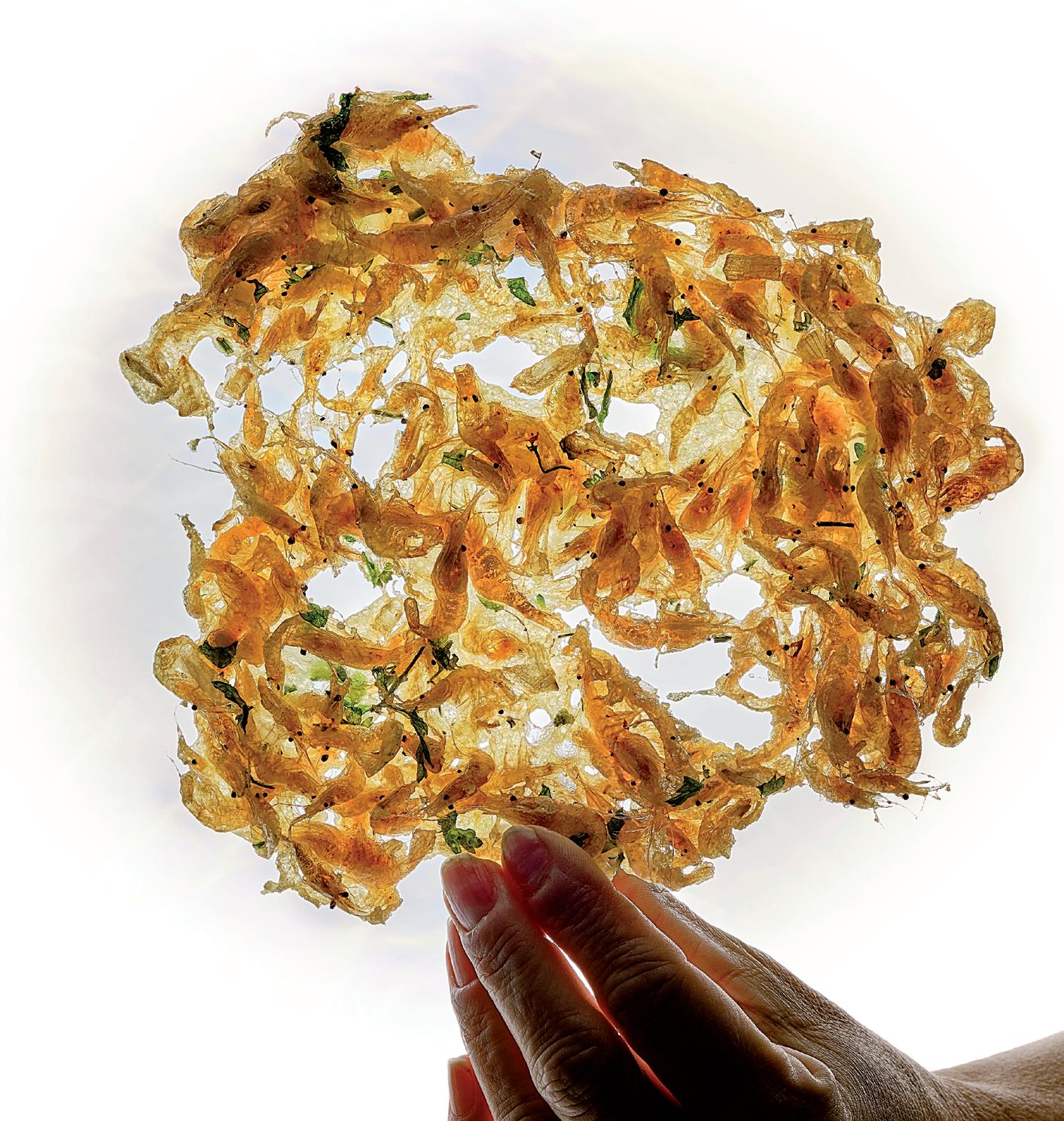
The local estuaries are like small lakes built around the salt pans to provide water to the places where salt is harvested. Thanks to a system of gates, once fish and shellfish enter the estuaries, they cannot leave.
Sea bass, gilthead bream, sole, mullet, shrimps and prawns come here to feed on algae, plankton and microcrustaceans. Estuary fish and seafood are known for their very high quality and are usually eaten grilled or fried.
Some estuaries can be visited all year long. Around November, all the fish in the estuaries are caught, grilled, and eaten in a traditional event called los despesques
Miyagi oysters grow along the coast of Cadiz and are now also farmed in estuaries. They are very similar to regular oysters. Locally, this type of oyster is known as ostión, while outside of Cadiz it is called ostra rizada. In English, it commonly known as Miyagi oyster, Pacific oyster, or Japanese oyster.
They are usually eaten raw, with their shells freshly opened, and in a single bite. They can also be coated in flour and fried. The meat is exquisite, but so, too, is the liquid surrounding it. These oysters are becoming increasingly easy to find in bars and restaurants.

The flavours of Cadiz
Rock fish are highly prized. They feed on small animals and algae found at the bottom of the sea. Red porgy (bocinegro) is especially famous, although most of it is exported to other European countries, where it more valued. Other fish in the same family include sea bream and gilthead bream.
The rock fish caught in the area around Conil de la Frontera are held in particularly high esteem. In fact, the local fishermen’s guild has its own brand to ensure consumers can easily recognise their products. These fish are especially delicious when baked, plain or on a bed of salt, and “adorned” with a little olive oil.

One of the most prestigious shellfish in Spain. Sanlúcar prawns now have a registered trademark that protects them from counterfeiting. They are found on the coast close to the city of Sanlúcar and are usually served cooked.
You can enjoy not only the meat but also the juice from their heads, which is one of their “added values”. They are the perfect pairing for a Sanlúcar manzanilla.
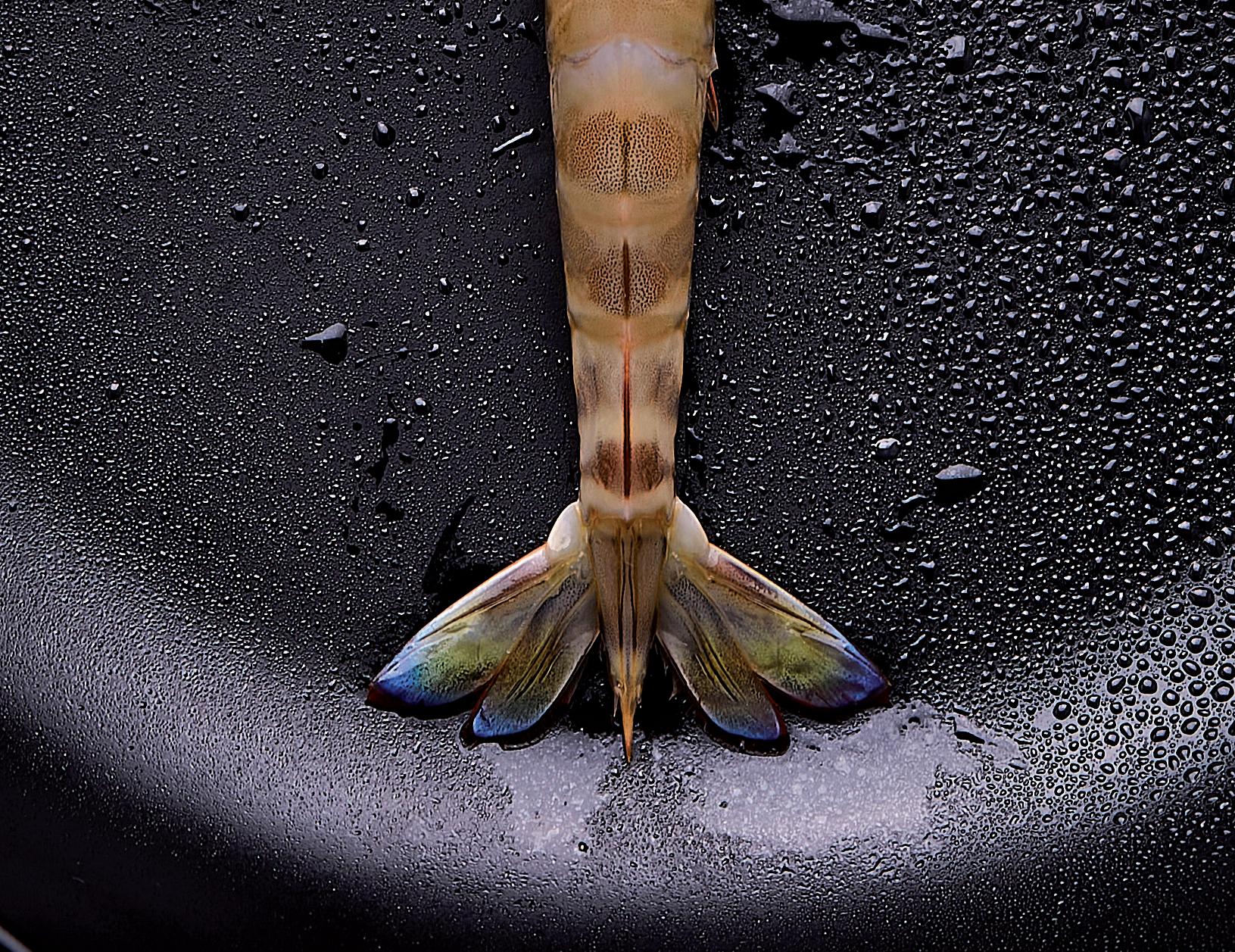
The flavours of Cadiz
One of the culinary jewels of Cadiz. Bluefin tuna are fished around the month of May in four almadraba nets located in Conil de la Frontera, Barbate, Zahara de los Atunes and Tarifa. A fifth net will soon be added in Chiclana.
The tuna caught in these traditional nets are especially prized because the meat is juicier, since the fish are “overfed” to withstand the long journey from the Atlantic to the Mediterranean. The restaurants along the coast of Cadiz are highly renowned for the ways they serve bluefin tuna (atún rojo). Three dishes are especially famous: vuelta y vuelta (grilled tuna), encebollado (tuna stewed with onions) and tartar (tuna tartare, small cubes of tuna are seasoned and served raw).
Nowadays, thanks to freezing techniques that allow it to be stored at minus 60 degrees, bluefin tuna caught in almadraba nets can be consumed all year round. However, special gastronomy routes are usually held in May so people can taste fresh tuna in the towns with almadraba nets.


This product has had a Protected Geographical Indication since 2015. This means that true salt-cured tuna from Barbate (mojama) bears a seal so it can be distinguished from other products.
It is known as ham of the sea (jamón del mar) because the curing method – covering the meat in salt – is similar to the technique used to cure Spanish ham.
Mojama is best enjoyed in thin slices, which can also be accompanied with a bit of extra virgin olive oil. There are several shops that sell it in Barbate.
Although they may look like a type of plant, sea anemones (ortiguillas) are animals that cling to rocks in the sea.
They have a truly unique taste. Before serving, they are usually cleaned, breaded and fried, although new ways of cooking them are emerging, such as mixing them into scrambled eggs (revuelto) or rice dishes. They taste like the sea and have a somewhat gelatinous texture.

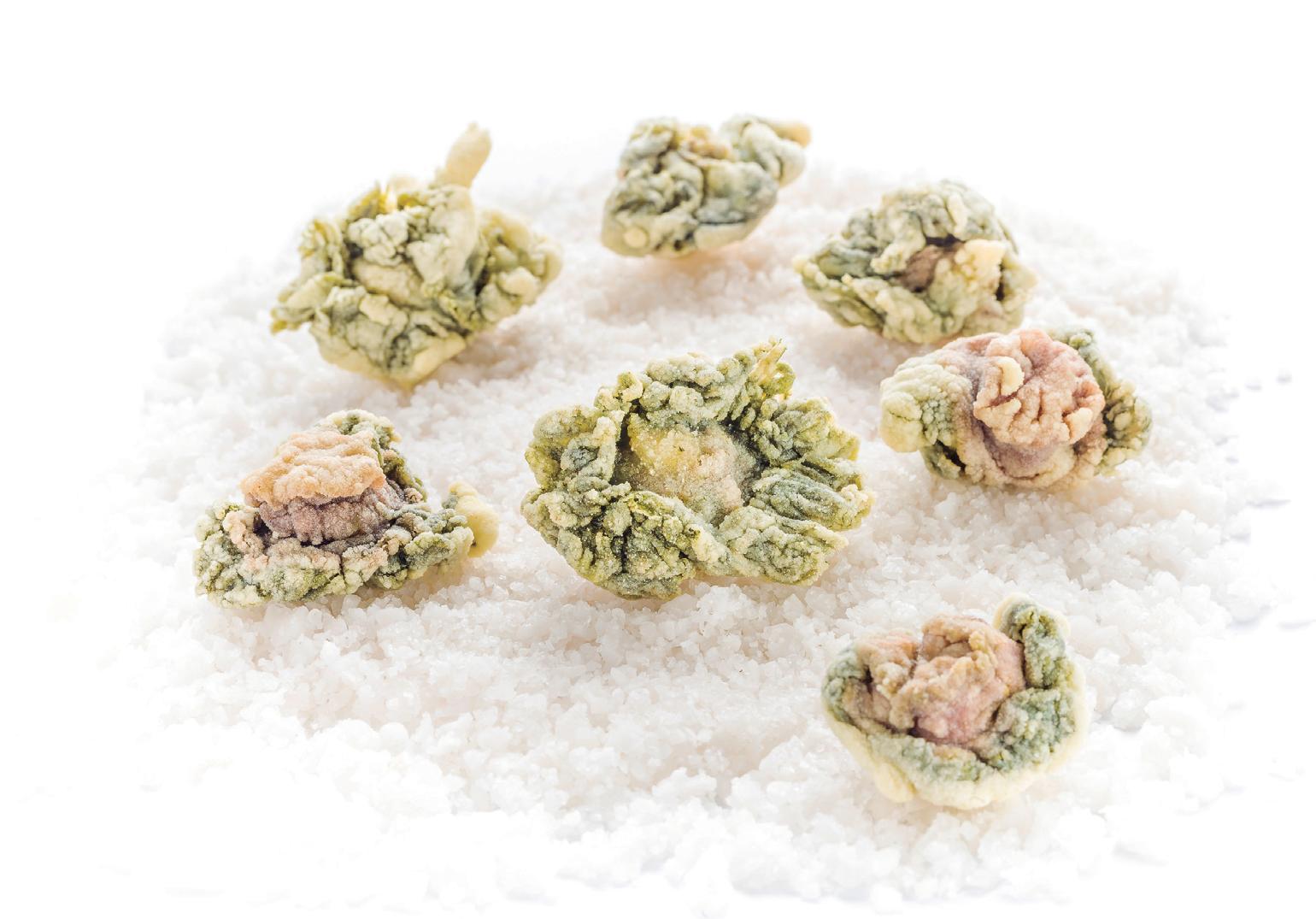

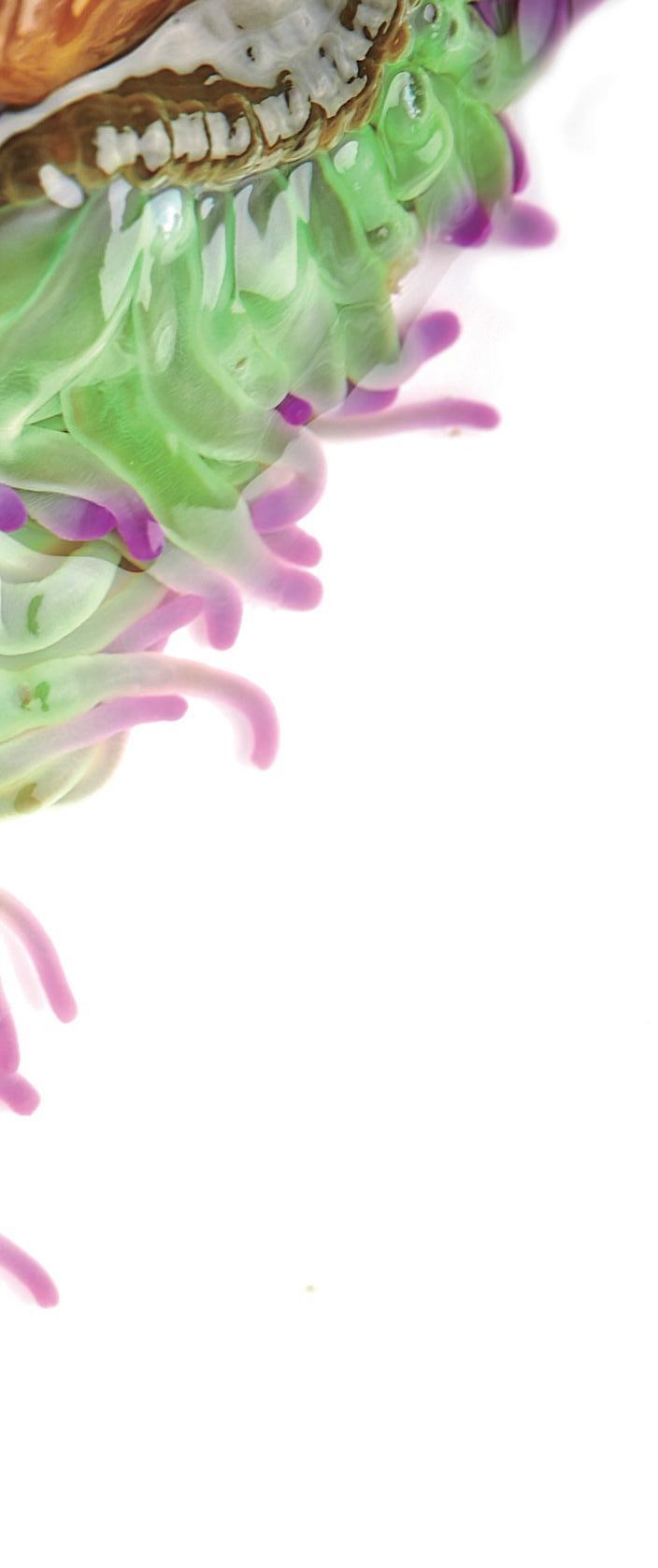

One of the province’s newest treasures, these plants have only started to be commercialised within the last decade. The most well known types are sea lettuce, ogonori, aonori and codium (also called sea ramallo).
They are sold fresh or dried and can be used in salads or sauces. However they’re used, they lend very pleasant aromas to the dish. Sea asparagus (salicornia), a plant from the same family, grows beside the estuaries and has a flavour reminiscent of asparagus, but with slightly salty notes. Scrambled eggs (revuelwith sea asparagus are a true delight.

This type of squid (calamar de potera) is caught with a jig, a special type of hook that allows the squid to be caught while they swim. This means that the cephalopod’s body is free of sand and arrives to the table in better condition.
They are fished off the coast of Cadiz and are most flavourful when grilled or fried. They are also served a la cochambrosa, which means they are not cleaned before being cooked.

These two fish are used to make high-quality preserves in the province of Cadiz, especially in Tarifa.
After the loins are boiled, the skin and bones are removed by hand. The clean meat is placed in tins and covered in oil.
There are two especially famous dishes made with these products: seasoned potatoes with bullet tuna (papas aliñás con melva) and a sandwich called el dobladillo, which is made with mackerel (caballa), mayonnaise and tomato.
The bullet tuna and mackerel produced in Tarifa belong to the Melva y Caballa de Andalucía Protected Geographical Indication. The factory that makes them has a shop open to the public.

The flavours of Cadiz
Smooth clams (concha fina) are similar to regular clams, but larger. These molluscs are usually eaten raw or lightly seasoned with a touch of lemon, if at all.
It is not easy to find them in restaurants, but if you do, they are well worth trying. They are juicy and taste deliciously like the sea. Rough cockles (corruco), another type of local mollusc, are similar to common cockles.

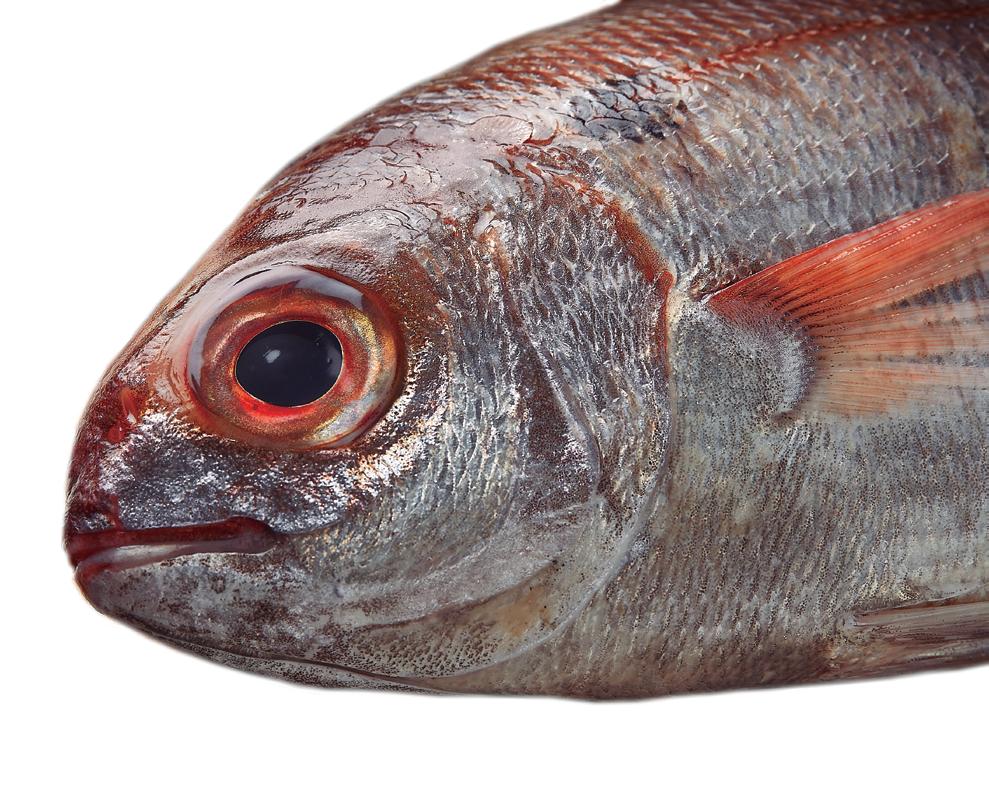
This fish, known as Besugo de la Pinta, is a registered trademark. Caught in Campo de Gibraltar, it is characterised by a black spot on its back.
It feeds on small crustaceans and marine animals, hence its nickname voraz, meaning “voracious”. It is most commonly served grilled or baked whole and is easily found in restaurants in Campo de Gibraltar.

The local salt pans once played a central role in the Bay of Cadiz. Although their visibility has diminished, companies continue to produce salt here, especially for the gourmet sector. One local product from Cadiz that has been attracting the interest of refined palates in recent years is fleur de sel (flor de sal): delicate flakes from the surface layer of the salt pans.
Another point of interest is the Roman salt pans at Iptuci in the Sierra of Cadiz, one of the few remaining “inland” salt flats in Andalusia. The salt pans are open to visitors and some also offer tastings of their products.
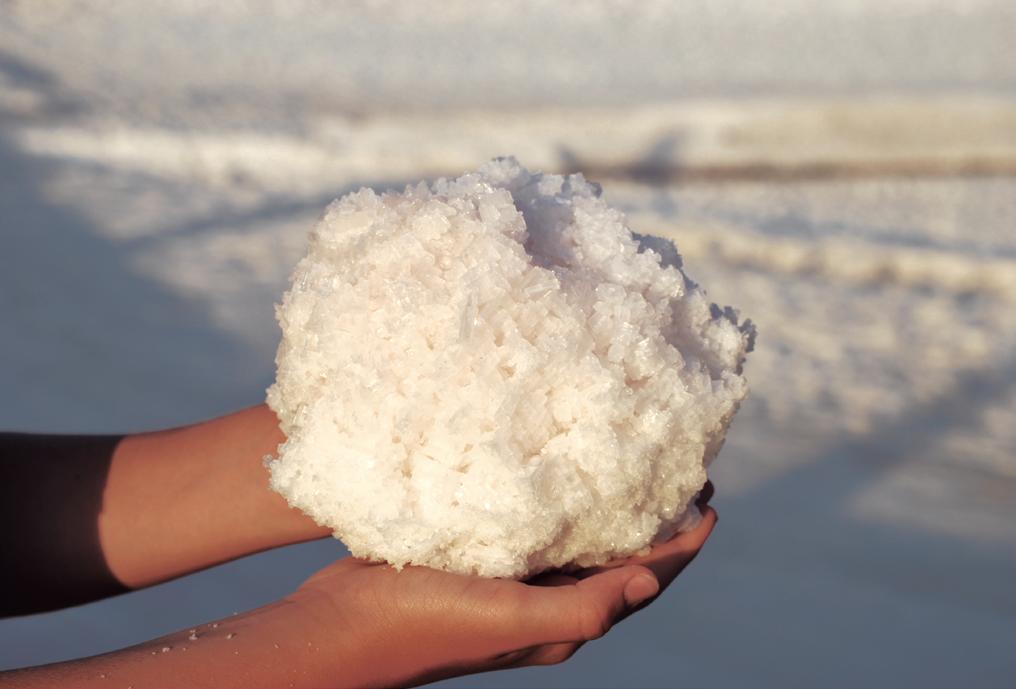



These types of establishments, known as freidores (fryers), are typical of the province, especially in the Bay of Cadiz. They serve fried fish in paper cones. The modern version of these shops usually includes a bar where you can eat the fish.
These places specialise in dogfish (cazón), a type of shortfin mako that is marinated and fried; fried cuttlefish strips (choco) and fried whole prawns. In some you can find another classic Cadiz dish: marinated moray eel (morena en adobo).
The province of Cadiz has become so famous for its cheeses that there are now more than 20 artisan cheeseries in the area.
The Payoya goat and the Grazalemeña Merino sheep are two characteristic breeds whose milk is used to make a variety of cheeses ranging from fresh to cured. Among the latter, cheeses cured in pork lard have become very famous, even winning international awards.
Most cheeseries have shops open to the public. There is a cheese museum in El Bosque and another in Villaluenga del Rosario.


Beef is very commonly raised in pastures across the province. Retinta is the most typical breed. Although it is not exclusive to Cadiz, its presence here has grown significantly.
La Janda veal has also become quite popular; it is usually a Retinto crossed with other breeds of cattle. This meat is best enjoyed grilled, although it is also featured in many local stews. There are several gastronomy routes throughout the year, such as the ones in Tarifa and Conil de la Frontera.
This dish, lomo en manteca, has become so popular that in recent years, an international day has been declared in October to celebrate its over 100-year history.
It is prepared by frying large pieces of meat in pork lard. To serve, the meat is usually cut into thin slices and placed in a sandwich. Lard is spread on the sandwich bread as well. In the roadside bars around Vejer de la Frontera, it is very common to have this type of sandwich for breakfast.


These establishments, called ventas, are a curiosity that have cropped up in the province of Cadiz. They usually have a few things in common: they have very interesting breakfast options featuring bread with lard spread; they sell food products; and finally, they serve delicious traditional dishes featuring game meat and stews made with chickpeas and white beans (potaje). Oxtail stew (rabo de toro guisado) is another one of these establishments’ specialties.

Vegetables have always played a secondary role, but towns like Sanlúcar de Barrameda, Chipiona, Conil de la Frontera and La Línea de la Concepcion are renowned for the quality of their vegetables.
They are best known for their potatoes and tomatoes, along with other green treasures from the province, such as asparagus from Alcalá del Valle and oranges from San Martín del Tesorillo. These products abound in the markets of these cities.

This way of growing crops is typical of Sanlúcar. The sandy areas near the beach are used for agriculture; specifically, small gardens that mainly grow vegetables. The use of navazos was in decline, but they’ve been revived by the arrival of new growers committed to bringing these vegetables to gourmet markets. Nowadays, growers are also experimenting with new products.


Although many types of mushrooms grow in Cadiz, especially in the Sierra of Cadiz and Los Alcornocales Natural Park, chantarellas are the most popular. They usually appear in the last months of the year. Jimena is particularly famous for the masterful ways this product is prepared in some of its restaurants.
Chanterelles are often cooked with small and large game. Deer, wild rabbit and partridge are the most common. In autumn, there are multiple gastronomy routes and even mushroom foraging tours organised by adventure tourism companies.
The flavours of Cadiz
One of the most outstanding sausages in the province of Cadiz. It’s found mainly in two villages in the Sierra: Olvera and El Bosque.
Morcilla de hígado from Olvera is only slightly cured – its softer texture makes it almost spreadable – while that from El Bosque is more cured. This product is made with pork liver, bacon and spices and served with cateto, a bread made in the Sierra de Cadiz which combines with it perfectly.

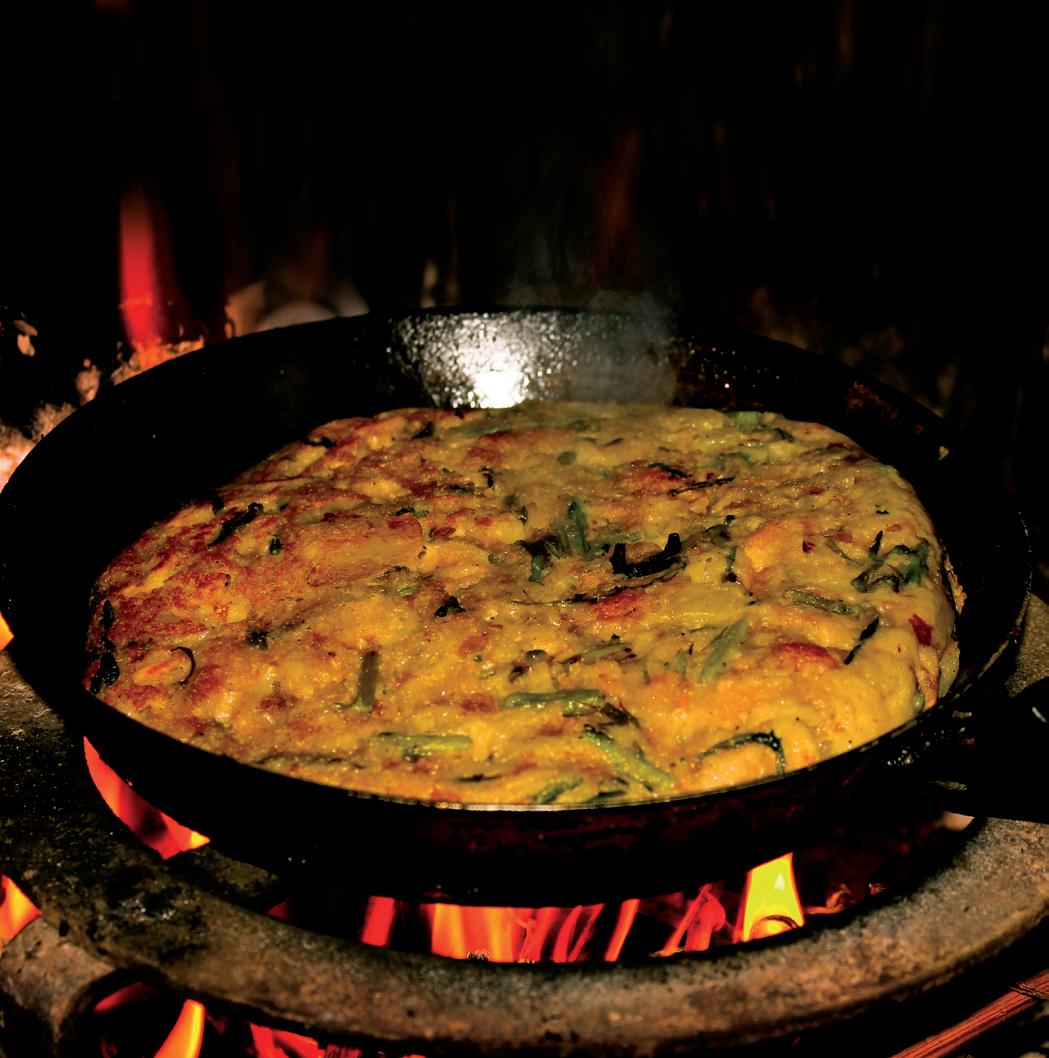
The dish is known by a different name in each village, but the recipe remains very similar. It includes a lot of bread, water, tomatoes and other vegetables, especially asparagus, when in season.
While it is called “soup”, it looks more like a Spanish omelette, although it hasn’t got potatoes or eggs. Its flavour is reminiscent of ajo caliente, a garlic-based “soup” which is also very popular in the area around Jerez. The ingredients are very similar to those found in gazpacho, but zopa is much thicker.

Crackling (chicharrón) is made from a piece of pork that contains both meat and fat. These pieces are fried in lard until they’re crisp on the outside and juicy on the inside.
They can be eaten hot or cold. This dish is not exclusive to Chiclana de la Frontera, but the crackling in this town is truly exquisite.
There’s another type of pork crackling which is made with larger pieces and then cut into very thin slices. It is a classic in the province’s taverns.
flavours of Cadiz
Olive oil from the Sierra de Cadiz has a protected designation of origin and wins over more fans with every passing day.
Although olive cultivation has spread to the Jerez countryside and areas of La Janda, the Sierra olive tree is the most typical, since it grows in mountainous areas.
The region produces extra virgin olive oils, some of which are certified organic. Lechín olives are the most widely used, although there are also other varieties. Several mills in the Sierra bottle their own oils, which can be purchased on site.


One of the world’s most famous wines, sherry (jerez) has a protected designation of origin and is among the most highly prized wines today. The ageing method, known as soleras and criaderas, ensures that the quality always remains consistent.
There are several types of sherry, including fino, amontillado, oloroso cream, Pedro Ximenez and palo cortao. Each has its own distinct flavour. These wines are best enjoyed using all the senses: smell, sight, taste and also a sense of history.
More recently, the province has also increased its production of red and white wines. Jerez de la Frontera and El Puerto de Santa Maria are home to many sherry wineries you can visit, some with tastings and a show included. The grape harvest festival takes place in September with a large number of wine-related events.

flavours of Cadiz
They say that it’s a “meditation” liquor to be savoured sitting facing the sea, after a good meal. It is made with airen and palomino grapes.
In the production process, which has a protected designation of origin, alcohol is added to make a liquor. This brandy can be enjoyed as a beverage, on its own or in cocktails, and is also widely used as a cooking ingredient. Besides brandy, in the province you can find other valuable liquors such as Cacao Pico, a liquor derived from cocoa beans whose history goes back almost 200 years. In Grazalema, some interesting liqueurs are also made with local herbs.
Many brandy-producing wineries are open to visitors.
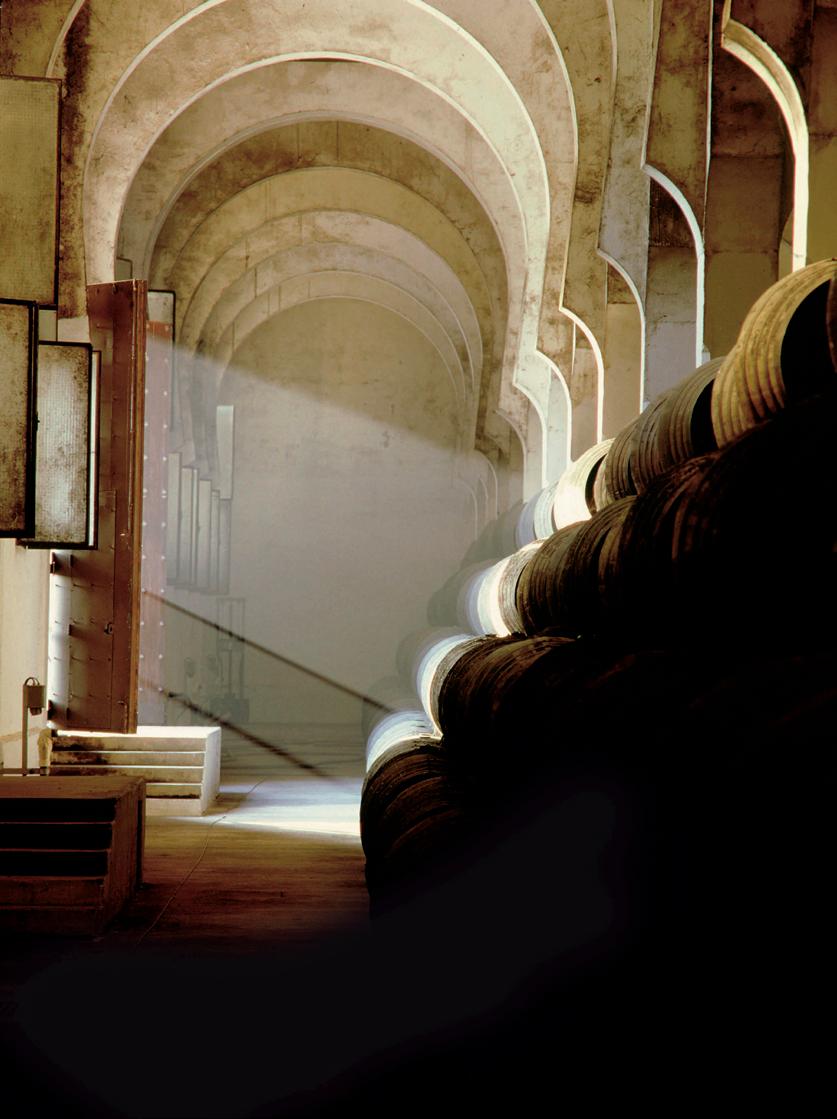





Vinegar is a product made from wine, or in this case, from sherry. It is one of the most common condiments in Mediterranean cuisine. Vinegar is widely used in salads and typical dishes in Cadiz, such as papas aliñás and adobo, a dressing used to marinate fish before frying.
It is also used in desserts, with very subtle notes that give sweet dishes a splash of personality. Sherry vinegar (vinagre de Jerez) has a protected designation of origin. Some wineries that produce it are open to visitors and sell to the public.


A typical wine from the city of Rota. The first records of its existence date back to the 17th and 18th centuries. It became a highly prestigious wine in Europe, although it later fell into decline.
It is made from a very small, red-coloured grape. Several wineries in the province are reviving the traditional product in two versions: dry and sweet.

Another of the province’s characteristic wines, moscatel is also linked to a specific city: Chipiona.
These sweet wines are made with muscatel grapes. The raisin muscatel (moscatel de pasas) is especially acclaimed. It is made by spreading grapes on the ground after harvesting so they can lay in the sun, a process called soleo.
Muscatel is very similar to Pedro Ximénez and is usually paired with desserts. Chipiona has a museum dedicated to this type of wine. The province of Cadiz is also home to another well-known muscatel from Chiclana de la Frontera, which is white. In Chiclana, you can find a very unique pairing: muscatel with butifarra, a local sausage made with cinnamon.

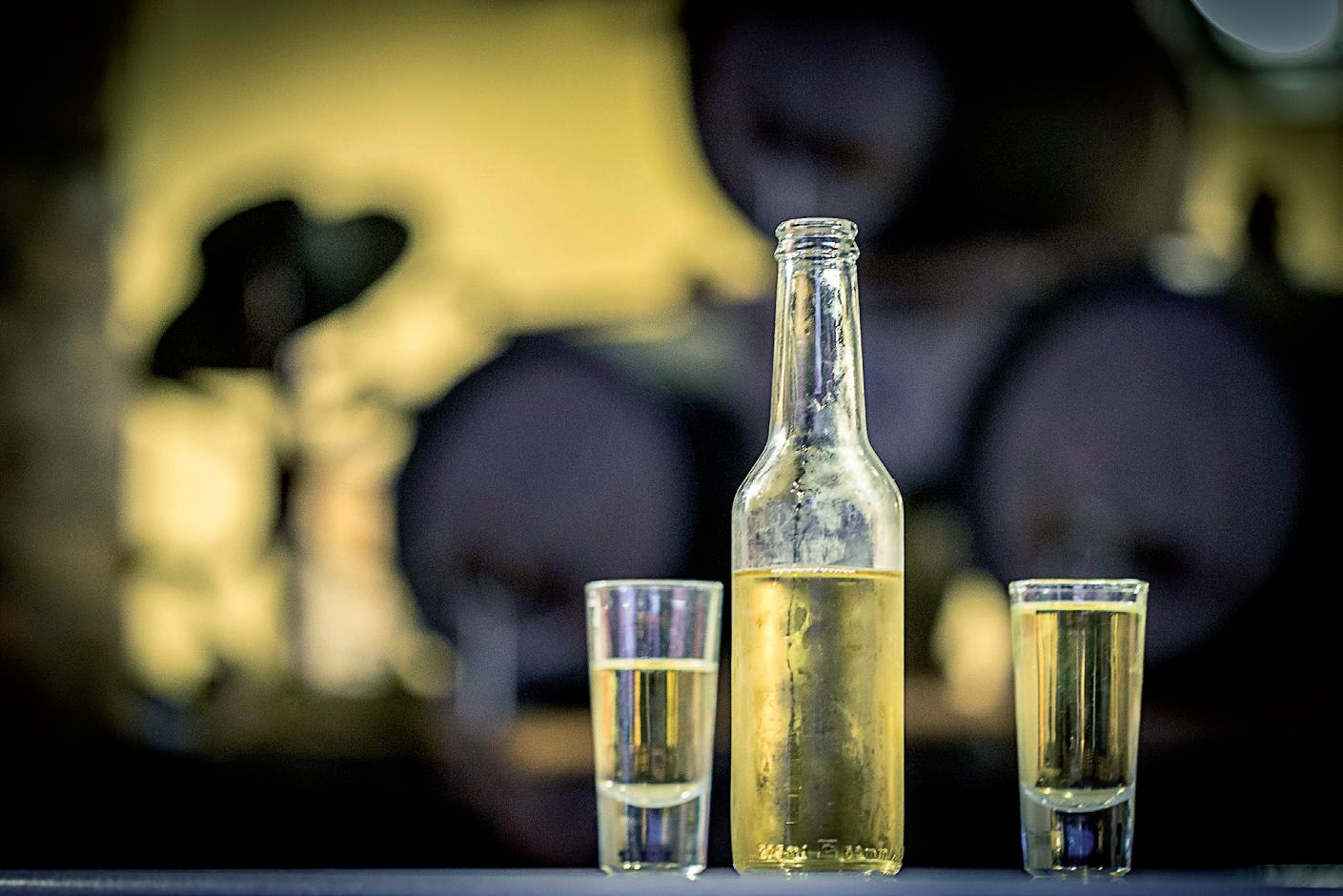

A unique wine enjoyed around November, when the cold weather begins. Mosto is usually made with palomino grapes which haven’t completed the fermenting process and are not yet “done”.
Cloudy with natural sediment, it is a very natural or “wild” wine.
This drink can be found in the taverns of Trebujena and other nearby towns, such as Jerez, and in rural restaurants called mostos, which open from November to March, during mosto season, and serve the wine (usually in jugs, not bottles) with cured meats, stews, and ajo caliente “soup”.
Mosto is also common in Sanlúcar de Barrameda.
The Jerez version of a tavern. Tabancos appear to date back to the 17th century and were places where tobacco, olive oil and wine were sold.
They reached their peak in the early 20th century as spaces dedicated to wine.
They are currently enjoying a glorious new era, having been converted into taverns where sherries are sold by the glass and served with tapas, both hot and cold. Some even host flamenco shows.
What more could you ask for?
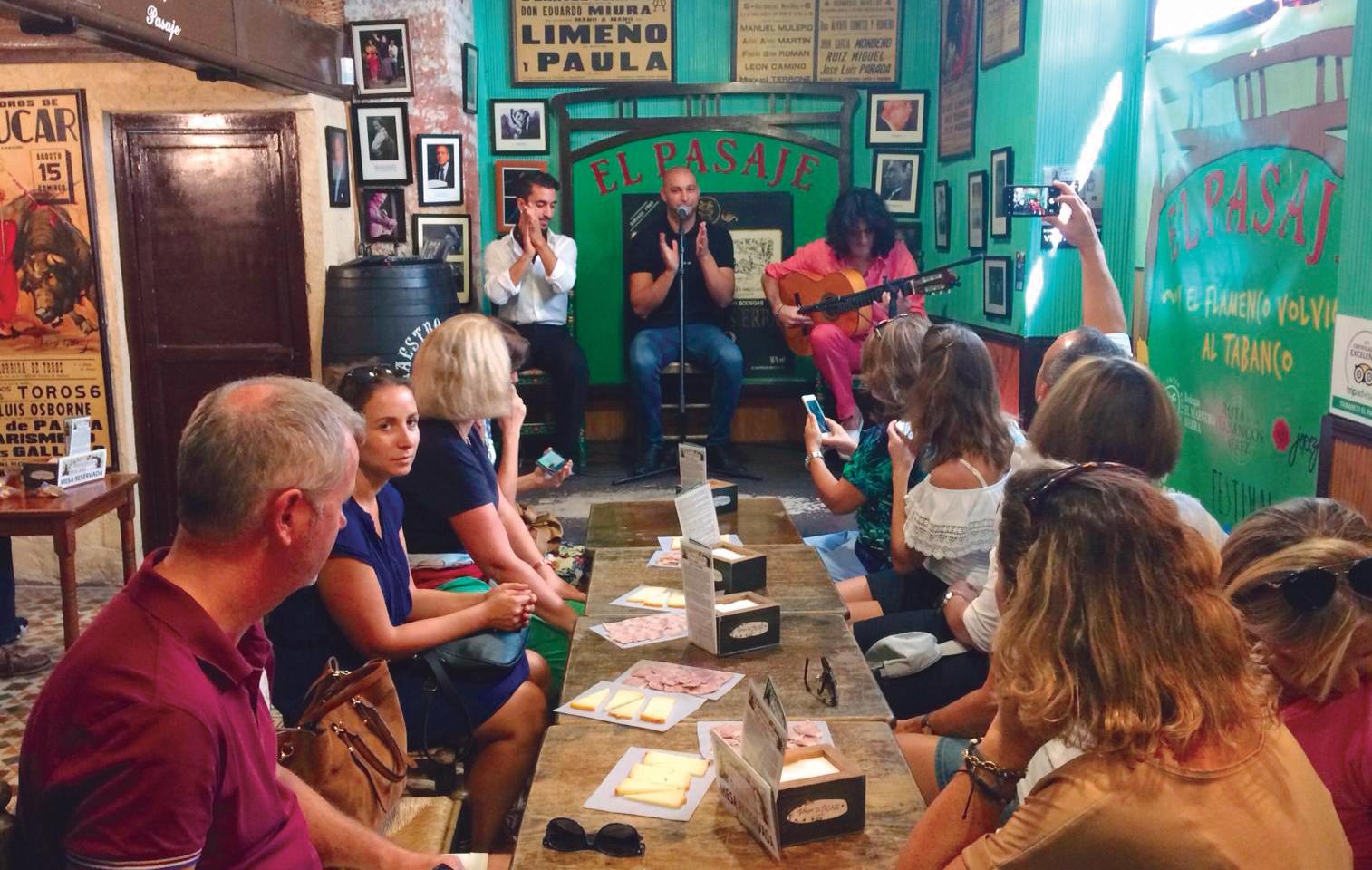

The best energy bar you can imagine. This very unique sweet treat, called alfajor, is Arabic in origin and has a Protected Geographical Indication. Shaped like an elongated cylinder and covered in icing sugar and a touch of cinnamon, its filling is made with honey, dried fruits, flour, breadcrumbs and a variety of spices that imbue it with a distinctive personality. The province of Cadiz produces a considerable amount of artisanal honey, which is held in high esteem. Although alfajores are mostly enjoyed around Christmas time, they are now made all year long.
Two other very famous sweets are made in Medina Sidonia: tortas pardas, an almond pastry filled with candied squash, and amarguillos, small almond marzipan sweets. Throughout the province of Cadiz, you can also find a special type of nougat (turrón) made with marzipan dough and filled with layers of candied fruit.


The flavours of Cadiz
One of the most widespread theories about the origin of tocino de cielo (“bacon” from heaven) suggests it was invented in the 14th century at a nunnery in Jerez de la Frontera.
Its success is tied to the local wineries. Impurities were removed from the surface of the wines using egg whites, and the leftover egg yolks were mixed with sugar to create this dessert. (Despite its name, it does not contain bacon). It has a texture similar to flan, albeit more solid. Also like flan, tocino de cielo is topped with a layer of caramel. This dessert is commonly found in restaurants and pastry shops across the province, especially in Jerez.


Bread comes in dozens of forms in the province, from cateto bread made with stone-milled flour, which has a firm crumb, to cundi or la viena. Another high-quality product is picos, which are small, crunchy bread sticks.
Mollete bread is outstanding, and different towns have their own versions of this soft bread, especially those in the Sierra de Cadiz. The most exceptional is the ablandao, a slightly plumper and spongier bread found in Bornos.
These doughnuts are typically filled with cream and fried in oil. The final step is to coat them in syrup made from honey. They are widely available in pastry shops throughout the area.

Produced by
Patronato Provincial de Turismo
Diputación de Cádiz
Plaza de Madrid s/n
Estadio Nuevo Mirandilla Fondo Sur - 4a planta 11011 Cádiz
Tlf: +34 956 807 061 info@cadizturismo.com www.cadizturismo.com
Texts José Monforte
Coordination and production
Olga Martín
Ana Pérez
Design and layout estudioActivo
Legal deposit CA 591-2018
Photographs
Aromas de Medina: Page 37.
Ayuntamiento de Rota: Page 33.
Ayuntamiento de Vejer de la Frontera: Page 22.
Bodegas El Gato: Page 33.
Carlos de la Calle: Page 11.
Carmen Romero: Page 19.
Consejos Reguladores de las Denominaciones de Calidad “Jerez- Xérès-Sherry” “Manzanilla-Sanlúcar de Barrameda” “Vinagres de Jerez” y “Brandy de Jerez”: Pages 29, 30, 31, 32, 34 and 36.
Compuertas Parque Natural: Page 18.
Emre Ruq: Page 28.
Francis Rosso: Page 2.
Gonzalo Höhr: Page 6.
Ignacio Fando: Pages 7, 18 and 38.
José González Cabello: Pages 20, 23, 24, 31, 34, 35 and 39.
Ignacio Santiago: Page 36.
José Ma. Caballero: Page 10.
Julieta Sánchez de Medina: Page 37.
Julio González: Pages 6, 9, 10, 11, 12, 14, 16, 17, 21, 22, 25, 26, 27 and 35.
Kiko Jiménez: Page 34.
La Trufa: Page 38.
Manuel Benítez Fernández “Gabaina”: Page 39.
Quesos El Bosqueño: Page 20.
Quesos Mangana: Page 20.
Roberta Sorge: Page 28.
Rafael Monge: Page 24.
Suralgas: Page 13.
Víctor Iglesias: Pages 26, 27 and 35.
www.elcastillodesanctipetri.com - Diego Gómez: Page 15.
Infograph estudioActivo
